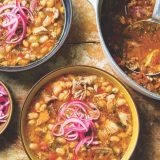After Irina Georgescu moved from Romania to Wales, she found herself wistful for the childhood chats and small rituals that went along with helping her mother and grandmother in the kitchen.
Making matters worse, recreating the tastes of home was hampered; she didn’t remember the recipes. “We never sit down and say, ‘Let’s learn how to cook a certain dish.’ We just do it,” says Georgescu, author of the cookbook “Carpathia,” a reference to the mountain range that nearly divides Romania in two.
Fortunately, numerous conversations with her mother filled in gaps that eventually accounted for large chunks of the book, which also reflects the influences of Romania’s 20 distinct cultural communities, creating a diverse cuisine that’s hard to pin down but big on bold flavors.
One flavor in particular stands out: sour. Most family meals include tangy pickled vegetables on the side and a hearty but brothy soup, or ciorbă, that features some sort of souring agent. Besides obvious ingredients like vinegar, cooks also rely on sour plum juice, pickling brine, unripe tomatoes, or borş, a tart, golden liquid made from fermented wheat bran (not to be confused with the beet soup common in other Eastern European countries).
In Georgescu’s recipe for ciorbă de porc, a homemade stock is fortified with borş or white wine vinegar, then paired with another defining Romanian flavor: smoke. She simmers smoked sausage in the tart stock with white beans, tomatoes and grated onion, carrot and celery. The soup then gets another punchy topping—pickled onions. The pronounced acidity of the broth balances the richness of the pork and the starchiness of the beans.
Georgescu recommends smoking the sausage at home in a roasting pan, but for ease, we used a smoked ham hock and bulked out the soup with the meat from a half-rack of baby back ribs. Topped with quick-pickled onions and fresh dill, our bright, brothy stew encompassed the hallmarks of Romanian cuisine—tangy, smoky and rich with flavor.






